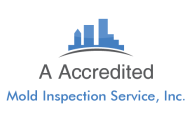Mold in the Home
A Brief Discussion on What Types of Molds Grows in What Indoor Environments.
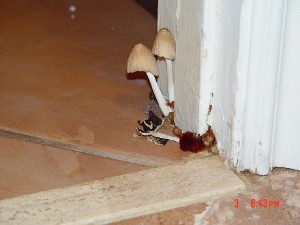
Mushrooms growing in a home’s door frame. Found by our certified mold inspector.
In nature different type of living organisms thrive in different environments. Mold in the home is no different.
Some house molds prefer some environments, while other prefer other environments. Let’s look at just a few common house molds and the types of indoor environments they prefer.
Penicillium chrysogenum Mold In The Home
This powdery white or green mold called Penicillium chrysogenum is one of the most common species of fungus found when inspecting for mold in the home. It can grow as the result of various common household moisture problems including humidity problems, condensation, and leaks.
Many molds in the home environment prefer leaks and very wet environments. What makes P. chrysogenum stand out is that this mold grows best in homes with no leaks at all! All you need for this mold to grow is high humidity. Even when no leaks have occurred it can grow profusely on clothes, furniture and other surfaces in humid homes. You often see it on clothes in closets. Eventually this mold will spread to every surfaces in the home if given enough time. In the below photos we see it growing in an attorneys office in Miami Florida. It had spread to every room of the office. We also see it on a nice leather coat in Palm Beach County. The mold growth was extremely heavy in that home. In both cases their were no leaks. The fact that this mold grows without leaks confuses many homeowners and even some mold inspectors.
When white spots appear on furniture and on clothes in closets it is usually this mold. Send a sample to the lab for basic sample analysis and they will call it Pen Asp. If you have a mold lab do more advanced analysis such as viable culturing, or DNA analysis, they will identify it more specifically down to the species level as Penicillium chrysogenum almost every time.
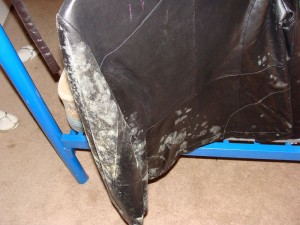
Humidity related Penicillium chrysogenum mold on a leather jacket found during a mold inspection in Lantana Fl near West Palm Beach.
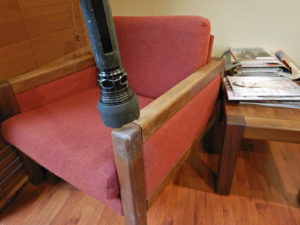
Humidity induced Penicillium Chryogenum growing on a chair in an attorney’s office in Miami Fl. The black object is the mold inspectors flashlight. To see this mold best you need a flashlight held parallel to the mold growth surface.
Humidity induced Penicillium Chryogenum mold
growing on a leather purse.
Purse is held by a client of ours in Miami.
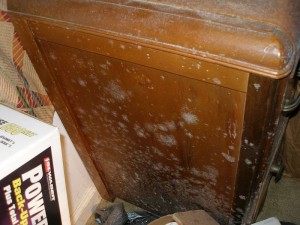
Humidity related Penicillium Chryogenum mold on the side of nightstand in Palm Beach County.
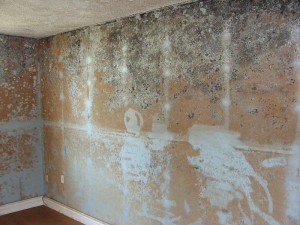
Various types of Pen Asp and Cladosporium mold on colorful walls in a South Miami area condo.
Aspergillus niger Mold In The Home
This is one of the water indicator molds. Unlike Penicillium chrysogenum, this mold requires building materials to be very wet before it grows. Therefore, if you find it in an air sample you know a leak occurred someplace in the home. It is common on cellulose rich building materials after floods and leaks occur indoors. It looks like Stachybotrys or toxic black mold. and grows in the exact same environments as Stachybotrys.
Though hard to differentiate from toxic black mold visually, it’s spores are quite distinctive under the microscope. The spores look like sea urchin shells without the spines.
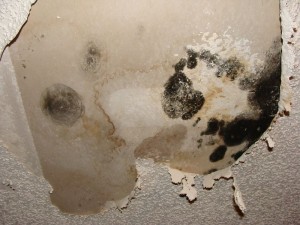
Stachybotrys toxic black mold behind popcorn ceiling coating found during a mold inspection in Fort Lauderdale. This mold looks nearly identical to Aspergillus niger.
Cladosporium Mold In The Home
Like Penicillium and Aspergillus, this is a contender for most common molds in the home. It is also one of the most common molds in the world. This mold will grow as the result of various moisture problems including leaks, and condensation formation but it dominates in areas of condensation. A little condensation is not enough for Stachybotrys or Chaetomium, but condensation is all Cladosporium needs to be happy. You will often find Cladosporium as black dots on cold metal AC registers where condensation forms. This mold is also common on the interior surfaces of AC units and AC ducts, and the exterior of air handlers inside humid attics.
Like most molds it is not confined to one type of moisture issue. This mold can grow in various environments including on water damaged walls, under wall paper, and on window sills. It dominates in low nutrient environments like metal and plastic. Cladosporium dominates on metal AC parts, tile roofs, and plastic lawn furniture. The reason is because other molds do not compete well on surfaces they cannot eat.
If you see black mold that looks like soot we call it sooty mold. It grows on harsh low nutrient surfaces that no other mold wants to grow on. If you see soot like black mold outdoors on a metal fence, concrete sidewalk, or a tile roof, it is very often Cladosporium.
However, some other molds like Alternaria may grow in the same manner.
Cladosporium mold on AC register that was photographed during mold testing in our area.
Cladosporium Mold resulted when high humidity formed condensation of a cold surface.
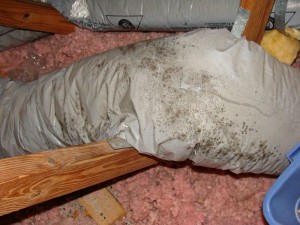
Mold growing on AC duct in a humid attic. When condensation forms on the exterior of the ducts Cladosporium mold commonly forms along with some Pen Asp mixed in.
Stachybotrys chartarum Mold In The Home
Also known as toxic back mold does best in very wet environments, it loves areas of flooding or more severe leaks. Get cellulose containing building materials soaking wet after a flood and in time this mold may grow. Unlike all the other molds we discussed, this one can be found inside wet houses but is seldomly found outdoors. It does not seem to like well lit sunny areas.
While many molds grow after flooding this one requires a little more time to colonize surfaces as it is not the first on the scene. I have found that after a flood occurs one of the above molds (Penicillium or Cladosporium mold may grow. When water damage is left un- attended for many months, or years then toxic black mold is more likely to form. You are more likely to find it inside a wall where leaks went un-noticed for months. Or it may be found in vacant foreclosed homes where severe leaks when un-repaired for extended periods of time. Curious about what this mold looks like when growing indoors click here. To see what it looks like in your petri dish home test kit click here. We have a picture of toxic black mold spores below.
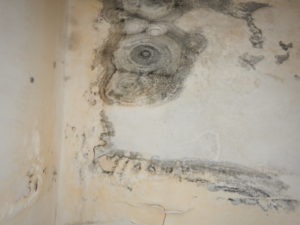
Close up of Toxic Black Mold found by our mold inspector in West Palm Beach Florida.
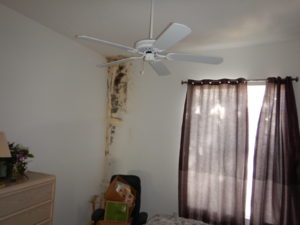
Stachybotrys toxic black mold growing in a West Palm Beach home we found during a mold inspection.
Chaetomium
This is a very common mold in the home. It is often found after flooding. It looks like cinnamon to the naked eye. Under the microscope the spores look like tan lemons. The first time I learned to identify this mold by sight was in a crawl space on the West Coast of Florida. I was doing an inspection for a very wealthy family with roots deep in Florida history. The family had a South West Florida county named after them! So much humidity and condensation had build up in their crawl space that the mold grew on every inch of wood in the large crawl space. In the above case excessive condensation caused the mold, but in most cases flooding is needed. Like Stachybotrys it does best in areas of flooding or leaks but it does not take nearly as much time to show up after a flood. Because it grows faster that toxic black mold, it beats it to the scene. Thus Chaetomium is more common indoors. It is very common behind baseboards and behind wet wall paper.
If you need a mold inspection to determine the extent of mold in the home.
If you need to determine what needs to be done to get rid of it properly call us at
A Accredited Mold Inspection Service.
We have been doing mold inspection since 2003.
We have no conflict of interest.
And we are licensed and certified.
Plenty of 5 star reviews.
